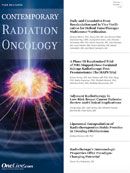Publication
Article
Contemporary Radiation Oncology
Declaring Our Objectives in This Inaugural Issue
Author(s):
As we embark on this inaugural issue of Contemporary Radiation Oncology, it occurs to me that the launch of every new journal is always made with the best intentions.
OncLive Chairman,
Mike Hennessy
As we embark on this inaugural issue of Contemporary Radiation Oncology, it occurs to me that the launch of every new journal is always made with the best intentions.
But a journal cannot be all things to all of its readers. It can only be successful if it stays focused on its objectives.
So what better time to declare those objectives than in the first issue?
Contemporary Radiation Oncology will:
- Share the latest advances in the science of personalized radiation oncology.
- Evaluate the treatment of acute and long-term complications of radiation therapy for head and neck, gastrointestinal, genitourinary, cervical, and breast malignancies.
- Explain state of the art treatment management for head and neck, gastrointestinal, genitourinary, cervical, and breast malignancies.
- Include clinical/practice updates about clinical controversies.
- Describe new advances in technology that may influence future treatment.
To be sure, attaining the objectives listed above will be difficult in each issue, but with dedication, these goals can be reached. I, for one, am excited about how the journal evolves to meet the needs of our readership.
To kick off this inaugural issue, we present 3 original manuscripts.
In “A Phase III Randomized Trial of MRI-Mapped, Dose Escalated Salvage Radiotherapy Post-Prostatectomy: The MAPs Trial,” Orman et al report on the feasibility and acute toxicity of 14 patients enrolled in a trial randomizing subjects to either standard 68 Gy radiotherapy or the same plus a simultaneous integrated boost of 76.5 Gy at 2.25 Gy/fx. If the authors show improved biochemical relapse-free survival (bRFS), then dose-escalation could become a new standard of care.
In the second article, Shah et al note that in women with low-risk breast cancer, there is a subset for whom adjuvant radiotherapy (RT) may not be appropriate. Current trials have failed to demonstrate a survival advantage from the local control benefit derived from RT. Trials are ongoing to identify these low-risk patients, but in the interim clinicians have alternative techniques including hypofractionated whole breast irradiation as well as accelerated partial breast irradiation, which allows for a reduction in treatment duration (and possibly treatment volume) while still maintaining local control.
In the third manuscript, Olivera et al test an automatic, multicenter procedure for in vivo dosimetry and verification (IV) and adaptive dose recalculation (ADR) for all patients and all fractions treated on 14 helical TomoTherapy units across the United States. Their manuscript, “Daily and Cumulative Dose Recalculation and in Vivo Verification for Helical TomoTherapy: Multicenter Validation,” describes a metric- driven system that flags potential issues, establishes trends, and determines possible clinical impact. This system could provide both internal recommendations for daily image-guided radiation therapy and clinical improvements using IV and ADR findings. Moreover, the authors’ final goal was to evaluate deviations of the cumulative dose at the end of the treatment using Quantitative Analysis of Normal Tissue Effects in the Clinic (QUANTEC) recommendations for organs at risk.
If you would like Contemporary Radiation Oncology to consider your manuscript for publication, send a copy of the manuscript with cover letter via e-mail to the managing editor, Tony Berberabe (aberberabe@ onclive.com). Here’s to a well-informed future.

























